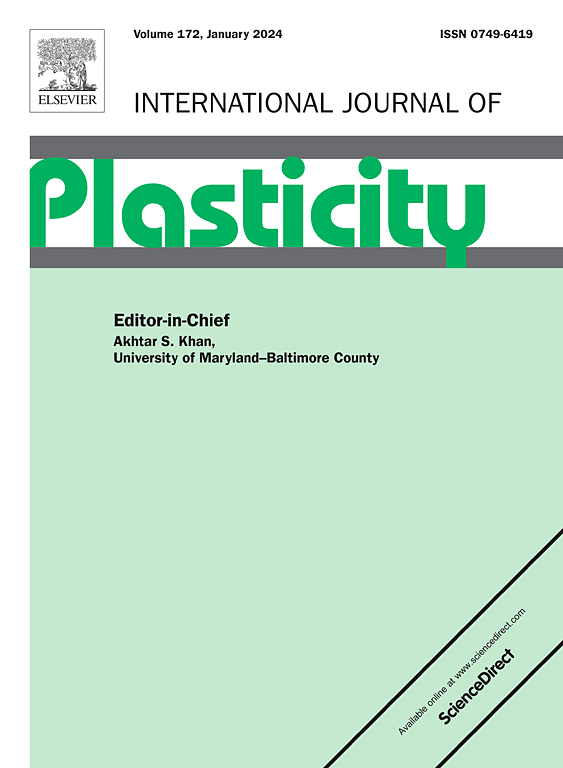基于双线性应变路径的压缩断裂应变表征
IF 9.4
1区 材料科学
Q1 ENGINEERING, MECHANICAL
引用次数: 0
摘要
本研究提出了使用双线性应变路径(预拉伸和压缩)的压缩断裂表征方法。压缩韧性断裂表现出极大的应变,这一直被认为是难以测量的。压缩载荷下的大变形会使试样的形状呈条状,并迅速改变应力的三轴性。由于这些复杂而巨大的应变,压缩断裂应变可被认为是在不会发生断裂的所谓截断区域内。为了简化压缩试验,需要一种能降低断裂应变范围的方法。单轴拉伸变形是一种应变路径,可诱导韧性材料内部空隙的增长,并导致韧性降低。韧性材料在压缩加载前受到预拉伸加载,会出现过早的压缩断裂。针对双线性路径的韧性断裂位置,选择了一个能够预测断裂区域的韧性断裂模型,并将其应用于不同预拉伸应变水平的数值模拟中。通过比较断裂试样形状和载荷-位移曲线的实验数据和模拟结果,验证了所提出的表征方法。本文章由计算机程序翻译,如有差异,请以英文原文为准。
Characterization of compressive fracture strain based on bilinear strain paths
This study proposes the compressive fracture characterization method using bilinear strain paths: pre-tension and compression. Compressive ductile fracture exhibits extremely large strain, which has been regarded as being difficult to be measured. Large deformation under compressive loading makes the shape of a specimen barreled and changes the stress triaxiality rapidly. Due to these complicated and large strains, compressive fracture strain can be considered to be within the so-called cut-off region where no fracture occurs. In order to enable compression tests to be easier, an approach that can lower the range of fracture strain is needed. Uniaxial tensile deformation is a strain path that induces the growth of voids inside ductile materials and leads to ductility reduction. Ductile materials subjected to pre-tensile loading before compressive loading can show the premature compressive fracture. A ductile fracture model capable of predicting the cut-off region is selected for ductile fracture loci of the bilinear strain paths and implemented into the numerical simulation with different pre-tensile strain levels. The verification of the proposed characterization method is performed by comparing experimental data and simulation results for fractured specimen shapes and load-displacement curves.
求助全文
通过发布文献求助,成功后即可免费获取论文全文。
去求助
来源期刊

International Journal of Plasticity
工程技术-材料科学:综合
CiteScore
15.30
自引率
26.50%
发文量
256
审稿时长
46 days
期刊介绍:
International Journal of Plasticity aims to present original research encompassing all facets of plastic deformation, damage, and fracture behavior in both isotropic and anisotropic solids. This includes exploring the thermodynamics of plasticity and fracture, continuum theory, and macroscopic as well as microscopic phenomena.
Topics of interest span the plastic behavior of single crystals and polycrystalline metals, ceramics, rocks, soils, composites, nanocrystalline and microelectronics materials, shape memory alloys, ferroelectric ceramics, thin films, and polymers. Additionally, the journal covers plasticity aspects of failure and fracture mechanics. Contributions involving significant experimental, numerical, or theoretical advancements that enhance the understanding of the plastic behavior of solids are particularly valued. Papers addressing the modeling of finite nonlinear elastic deformation, bearing similarities to the modeling of plastic deformation, are also welcomed.
 求助内容:
求助内容: 应助结果提醒方式:
应助结果提醒方式:


